Before people start questioning the title of today’s blog, please let me clarify that the Great Gray Owl is the world’s longest owl with a recorded body length of up to 33″ (and a wing span of over 60″). You may want to think of this a deceptive length as it is the large head and fluffy feathers (better insulation) that are hiding a proportionally smaller body, such that many other owl species are heavier than the Great Gray. Anyway, the take away is that the Great Gray Owl is a very large and majestic looking bird, which I believe is captured in this first image which is also my favourite owl image from this past winter.
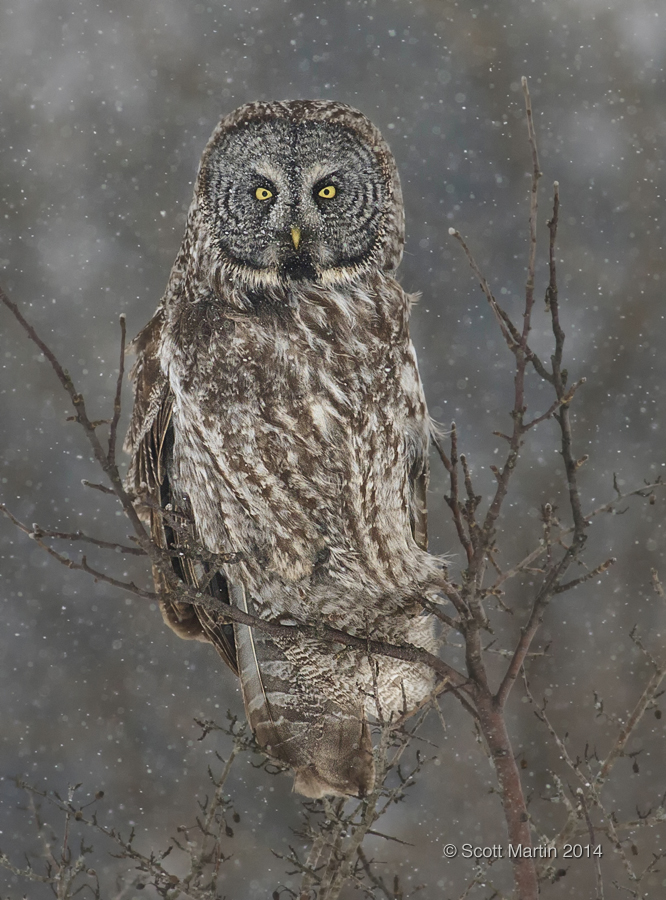
The Great Gray Owl is a northern owl that breeds in the far north regions of North America, Europe and Asia and although a nomadic bird, they do not migrate. As non-migratory birds, they are sometimes seen farther south than normal in years when food sources in the north are scarce and competition for food forces some birds to head south until they find more abundant food that they can successfully compete for. Their diet is 80% small rodents (voles and mice) and 20% from alternate prey sources including small birds and ducks.
This winter we were fortunate have a Great Gray Owl take up residence just north of Brooklin Ontario, not more than a ten minute drive from our house, which provided plenty of opportunities to photograph this celebrity visitor. And a celebrity it was, attracting birders and photographers from many miles away on a daily basis.
You probably noticed the image above was shot while it was snowing, which certainly adds to the photograph and serves as a reminder get out there when it’s snowing (or raining) as some of the best images are obtained in inclement weather. When it’s snowing you do need to take some time to think about how the snow will affect the image and how you wish the snow to appear in the image, just as you would for any of the elements that occupy the frame. Personally, I prefer the snow to be either frozen in the frame (pun intended :)) and appearing as round flakes, or heavily blurred to illustrate the wind and provide that winter storm look. An exposure time that allows just a little bit of movement in the flakes creates an unappealing optic with the snow appearing as a distractive cloud of gnats. The first image above was taken at 1/2000 sec, which preserved the round snow flakes. This next image was taken at 1/500 sec, allowing some motion in the snow flakes and creating that unpleasant fly look which you want to avoid.
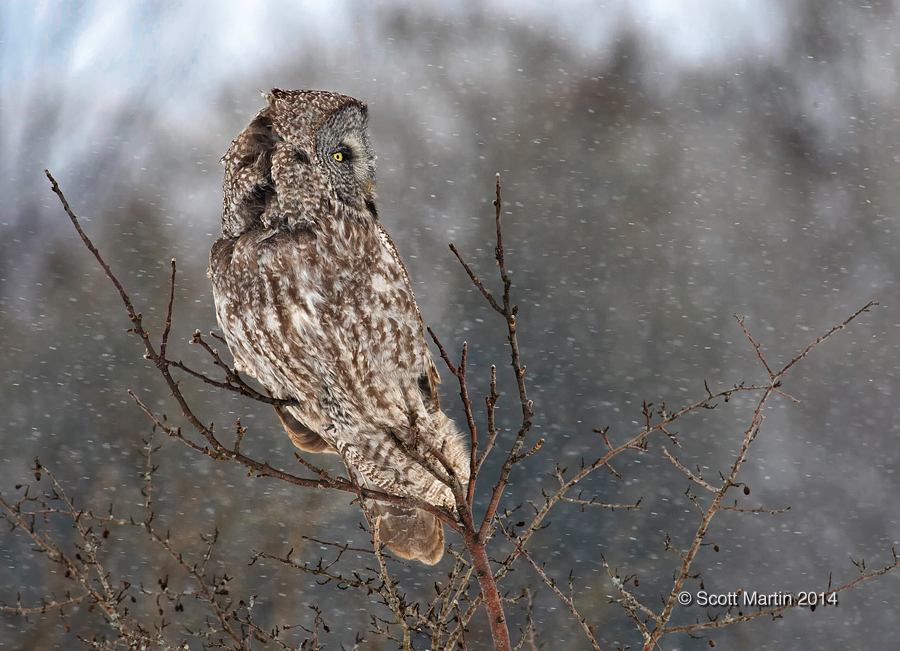
A much slower exposure of 1/30 sec was used for the next image which fully blurs the snow, but in a way that contributes to the success of the image by giving the feeling of the wind driving the snow.
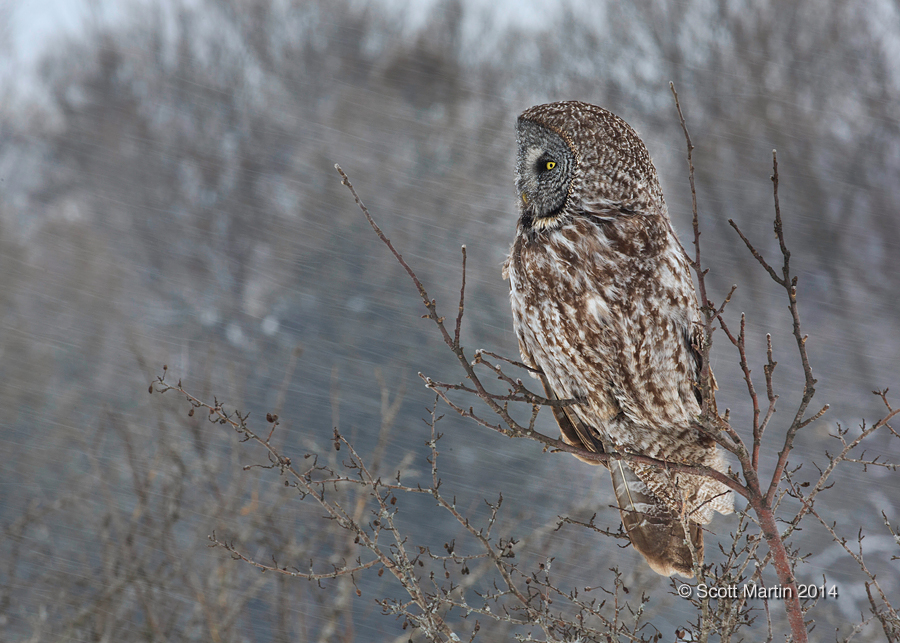
The challenge with slow shutter speeds is causing out of focus results either from camera shake or object movement during the exposure. So even using a lens with image stabilization, mounted on a tripod, I took at least a dozen shots to finally get one with the owl in sharp focus.
The next time you have the opportunity to take your camera out into the snow, don’t be afraid to do it, but always think about how the snow will impact your images and experiment with different shutter speeds until you create the desired effect. Also, when photographing birds, remember that slow shutter speeds are always the last thing you experiment with and don’t forget to set your exposures back to high shutter speeds as soon as you get the shot you want. Nothing is more frustrating than missing an owl launch from its perch while you have your camera dialled in at 1/30 sec! Fortunately I was back at 1/1600 sec for this next capture.
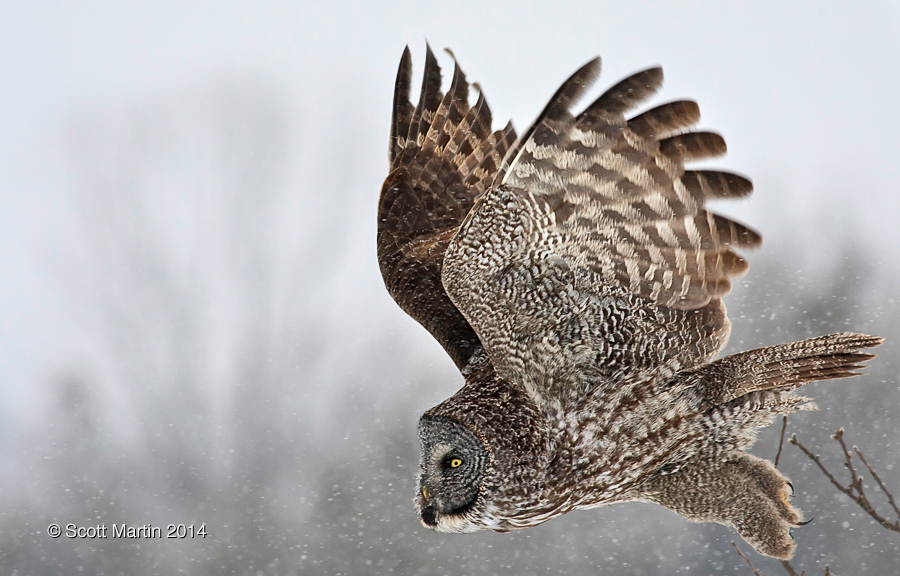
When shooting in less than ideal weather, the light is often quite nondescript producing the white/grey back grounds that typically are not visually appealing. However always try to use the light to your advantage. The over cast lighting reduces the natural contrast between the light & dark areas in the frame which is sometimes referred to as high key lighting (especially when there are no fully black shadows in the image). If you don’t like the high key look you can always add blacks and contrast during post processing which is what I did in these next few images.
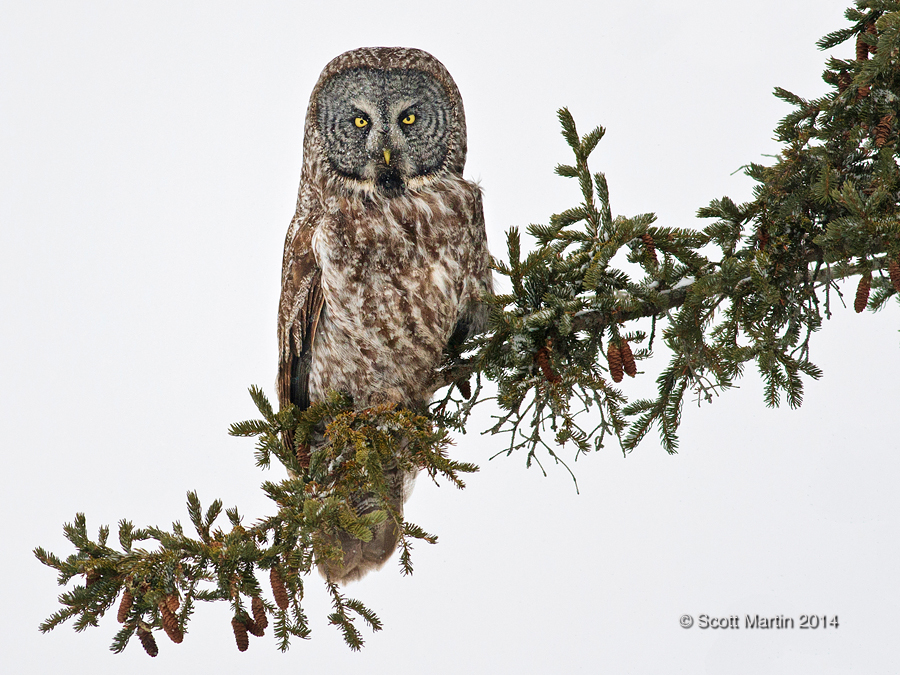
Images like these with an all white back ground are perfect to use as title slides in any presentations you may be doing.
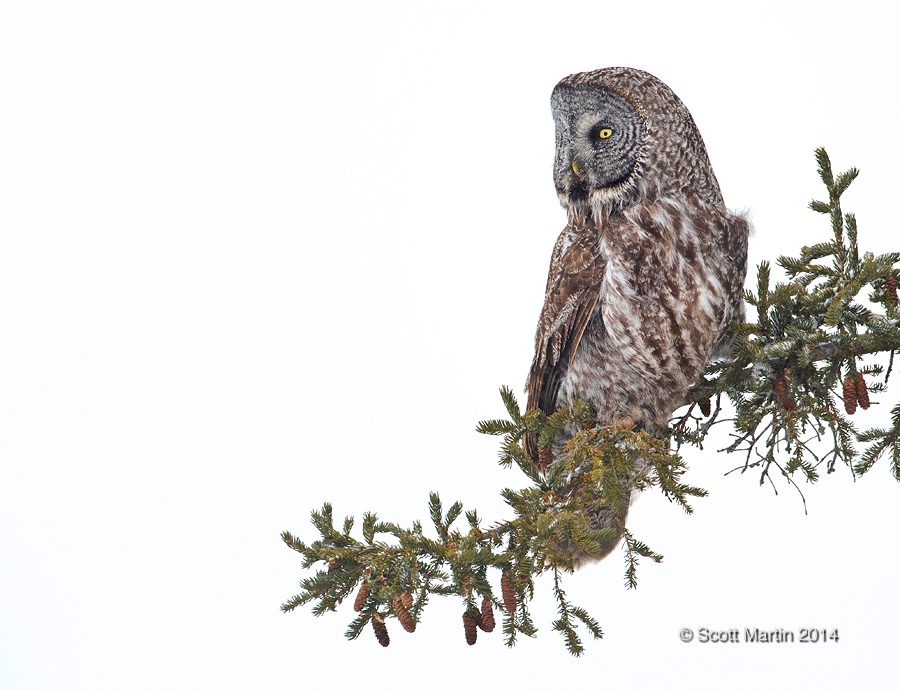
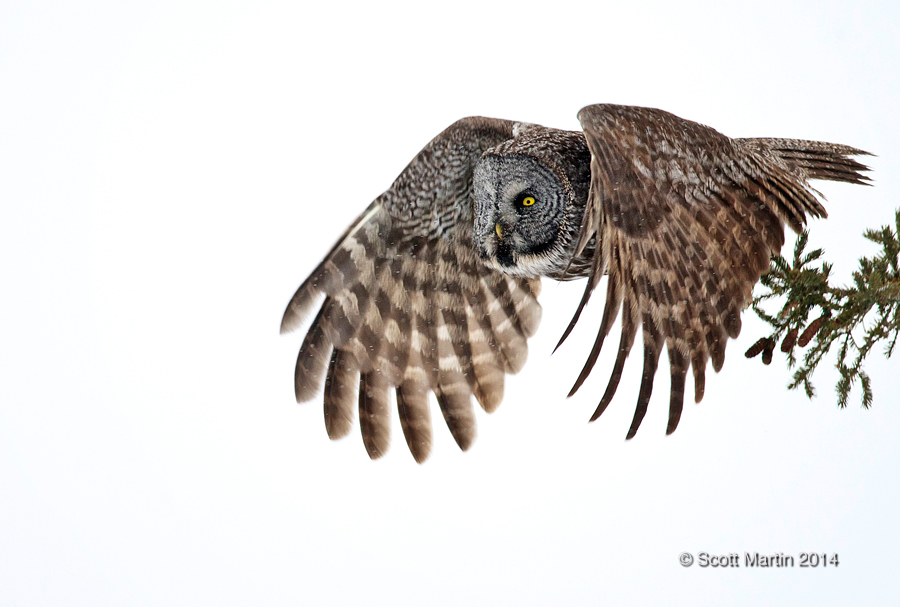

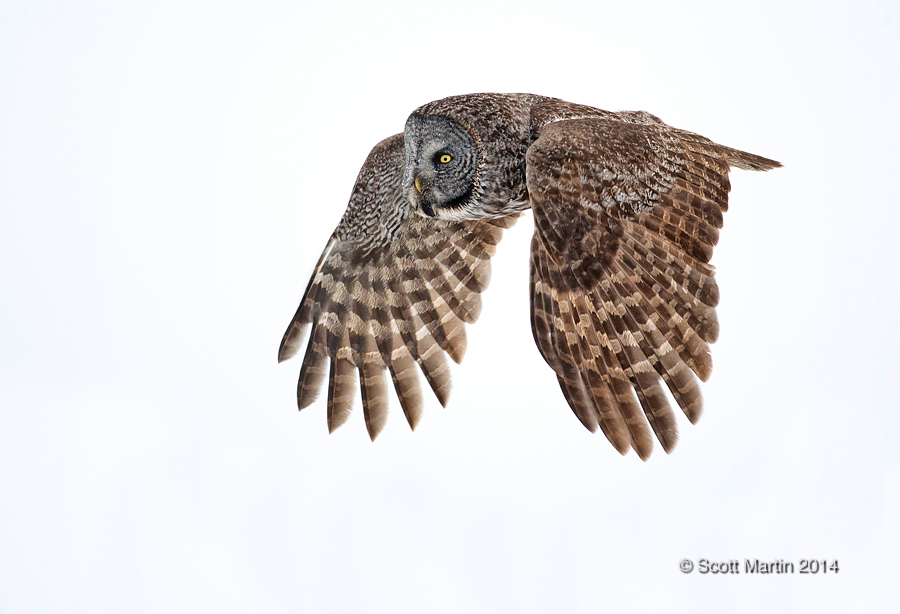
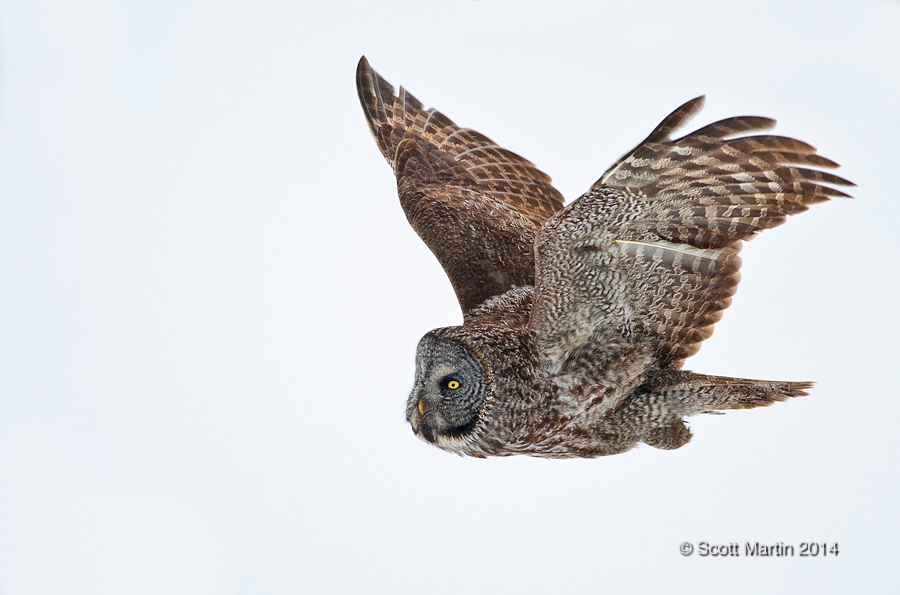
Bird photographers are usually upset when they cut off parts of the bird, but sometimes these accidents work out well. This next image is almost completely un-cropped in post processing (about 15% of the right side of the image was cropped). It just so happened that the owl landed on a perch very close to me and the 400mm lens was ‘too much lens’ so the owl more than filled the frame. The image does capture the concentration, intensity and focus of the owl securing the landing position on the perch it had chosen. Although accidental, the resulting image became a ‘keeper’.
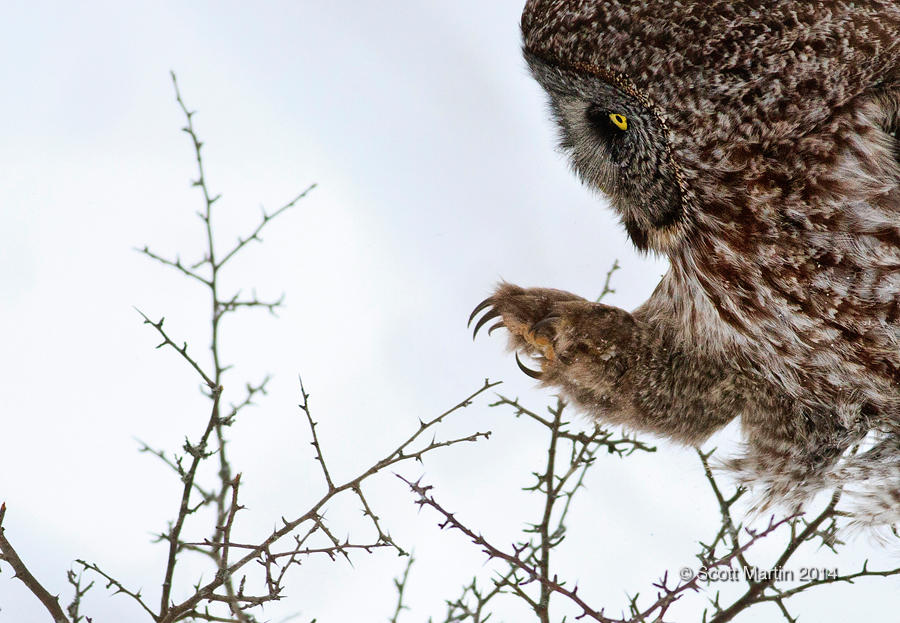
This next image is a crop of a missed launch image taken as the owl took off from its perch and I cut off the head of the bird. The intent then became to crop the image to isolate the legs and tail and convey the great power required for the owl to propel itself into the air. I don’t believe this image works as well as the previous one to convey the message, but the point is, don’t always delete your ‘mistakes’ before looking at them closely to see if perhaps there is a picture within the picture that can be used for an intent other than originally planned. They don’t always work (as shown in these two images) but when they do, it is a pleasant surprise.
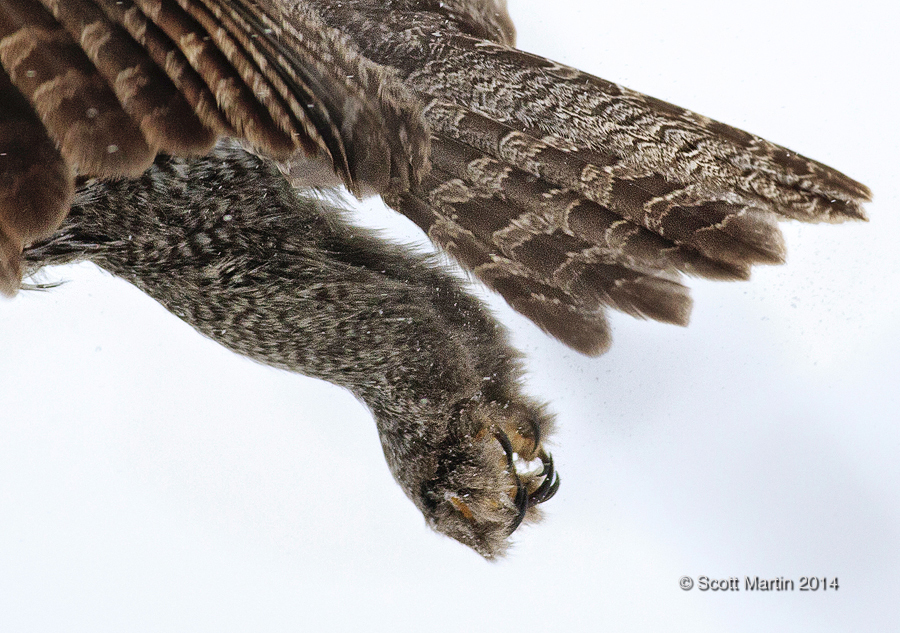
The last sequence of images in today’s post illustrates one of the typical hunting methods of the Great Gray Owl.
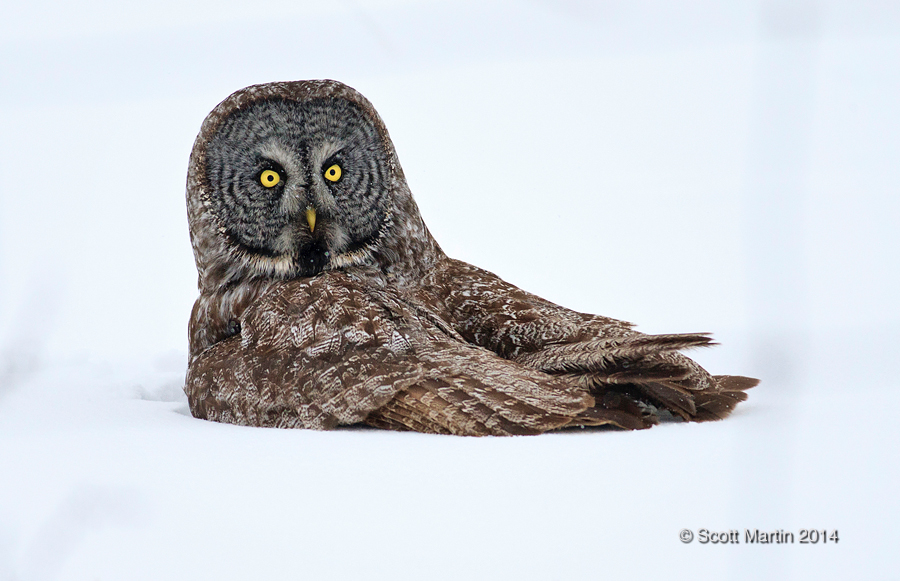
Great Gray Owls use sound and hearing as the primary sense required to effectively hunt for food and although they do have incredible visual acuity, they are most active feeding before dawn and after dusk when hearing is more important than sight. Their large facial disks act as parabolic reflectors amplifying and concentrating sounds on their asymmetrically located ears allowing them to accurately locate prey, up to two feet below the surface of the snow. This is truly amazing when you stop to think about it.
Listening intently to locate the prey.
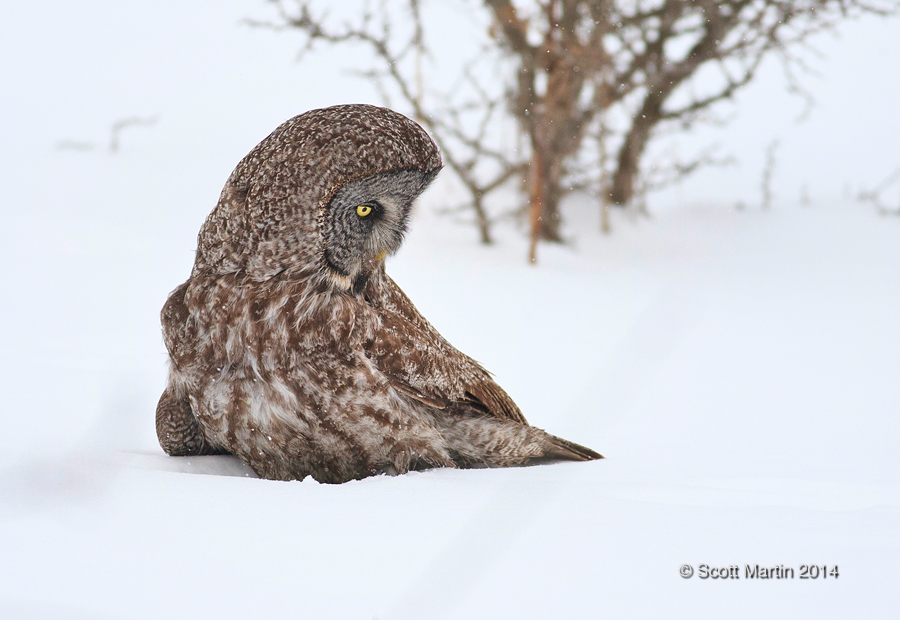
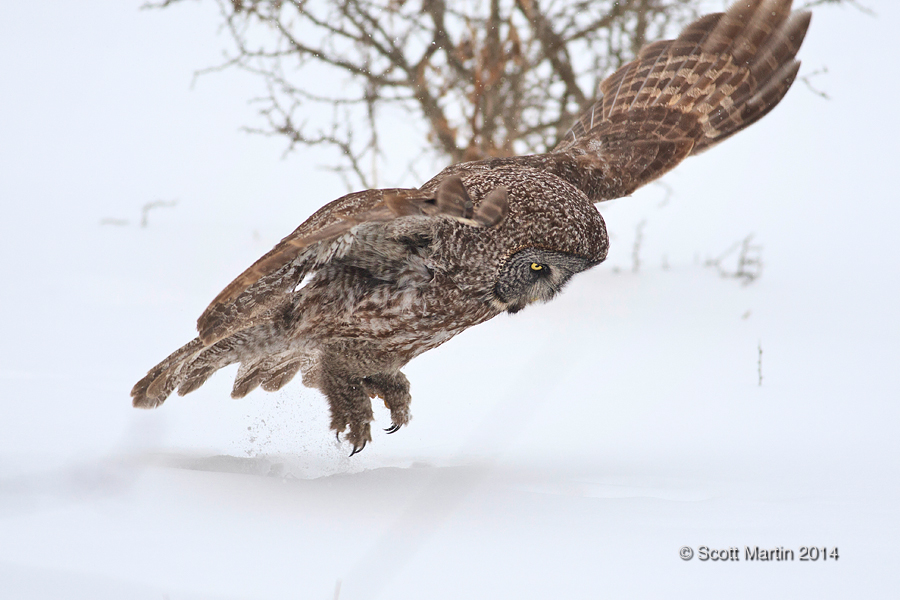
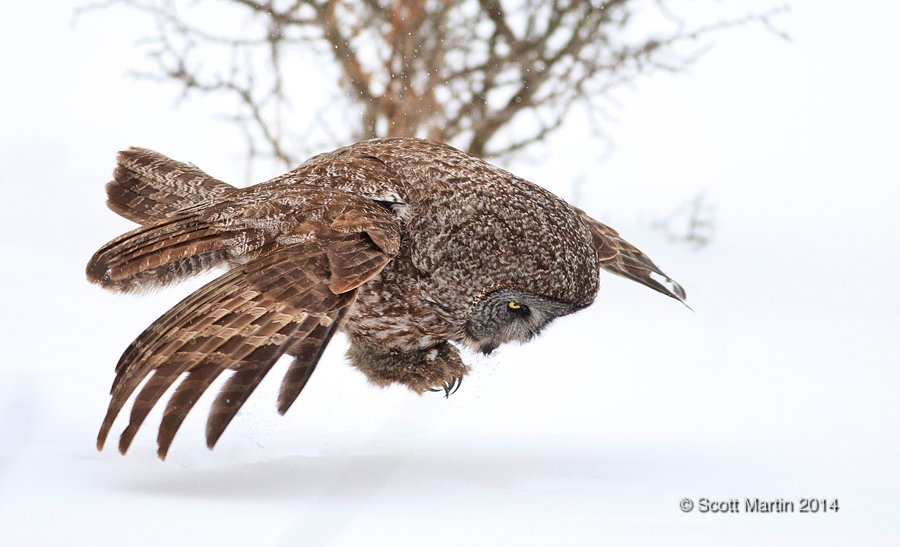
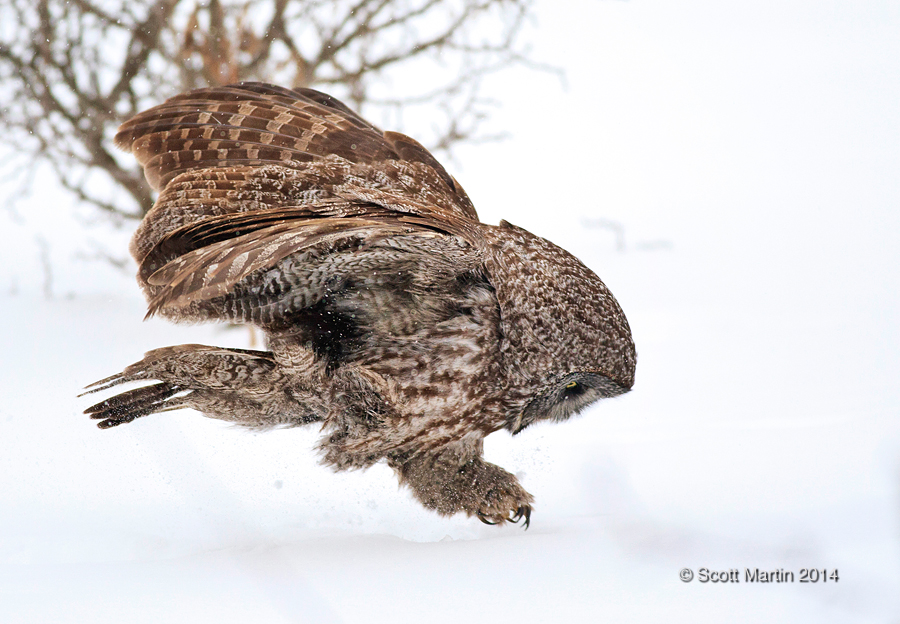
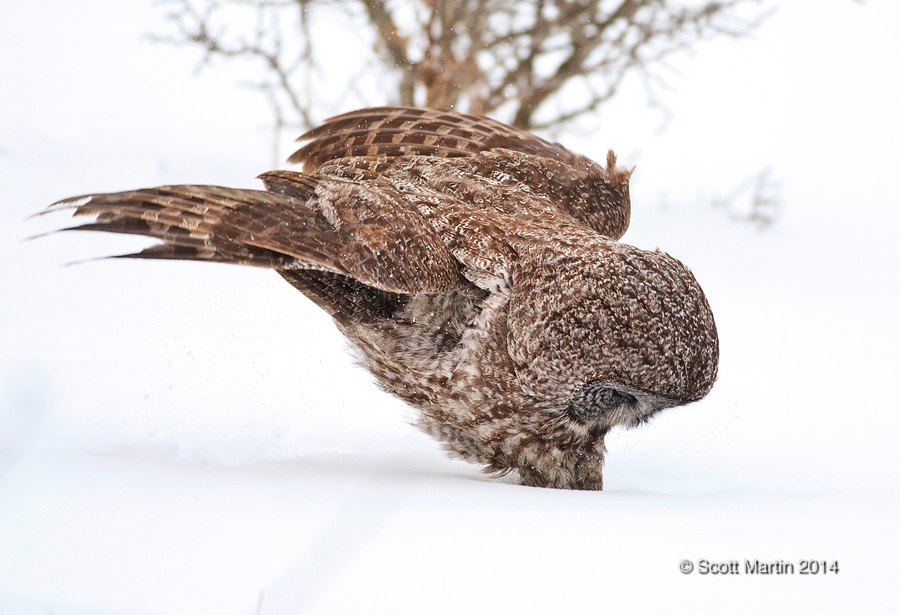
Hopeful success.
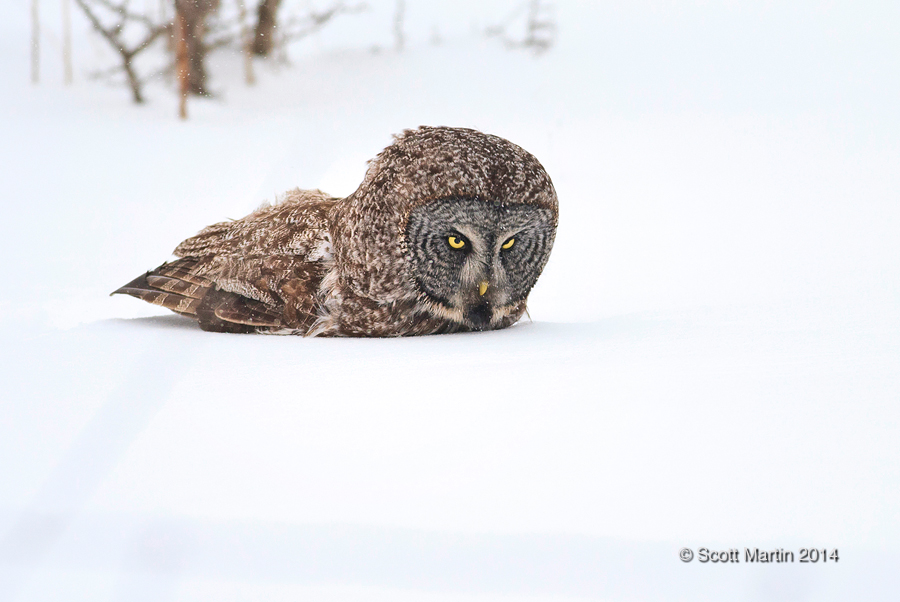
The images posted in today’s blog were taken with two different gear combinations, a Canon 5D MkIII with a 500mm lens and a Canon 1D MkIII with a 400mm lens.
It is always a pleasure to spend time out taking pictures, however it’s even more special when you get to do so with great friends and on the day we took these pictures Deb & I were joined by Arni & Dianne who made the trek south from Orillia to see the Great Gray Owl. You can see Arni’s shots of the Great Gray Owl posted on his blog.
I trust you enjoyed seeing these Great Gray Owl images and as always, your questions, comments and critiques are much appreciated.

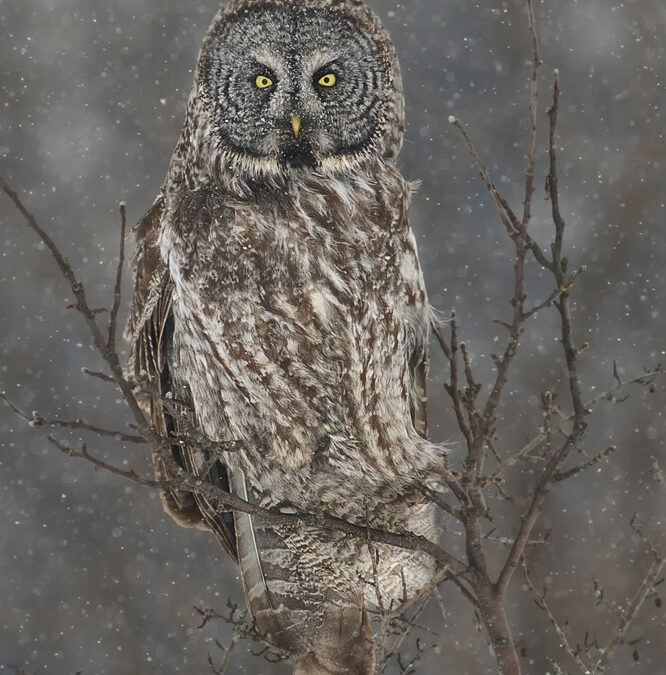
Wow, what beautiful images of an amazing creature!
Thanks Miriam and they truly are amazing!
This is a very interesting and informative post Scott. Fantastic photography to catch the owl in various stages of flight! Mom especially likes the one showing his head, eye and leg, checking out his landing perch.
Thanks Dad & thats one of my favourites too.
Fantastic!
Thanks Don.
What a handsome owl! These pictures are amazing… You can see every detail on this stunning creature. Wonderful work!
88
Thanks Lou & I’m glad you liked them! 88
Scott:
What an incredible series of shots on this bird. A super and very informative write-up to go with the photos makes it even better
Thank you for sharing.
Thanks so much for your kind comments John and I’m glad you enjoyed the post.
Excellent Photos!
This is such a rare bird, you are very fortunate to be able to witness such a thing!
Amazing shot of him in flight!
Thanks Stace! Too bad you weren’t there too.
This is a super post Scott and a memorable great day with friends. I remember the day well and I am glad that both of us were able to bring home some keepers. My fingers have finally warmed up too 😉
Thanks Arni and next time the temperature will be better!